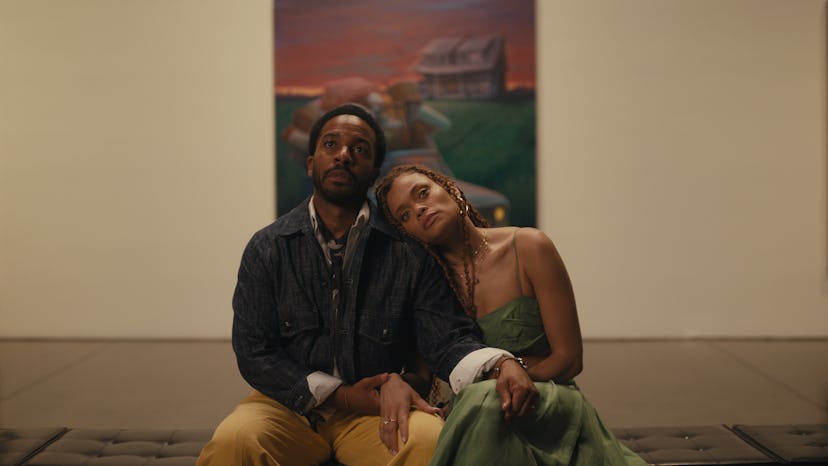Titus Kaphar’s haunting and powerful feature directorial debut, Exhibiting Forgiveness, required everything of the artist. The semi-autobiographical film, about a successful American painter navigating familial trauma and forgiveness through his artwork, expands on the themes found in Kaphar’s previous works to riveting effect. It also helped heal Kaphar himself.
Tarrell Rodin (played by André Holland) is the celebrated artist at the center of Kaphar’s film. Rodin lives with his talented musician wife, Aisha (Andra Day), and their young son in a beautiful suburban home on the East Coast. In the real world, that artist is Kaphar, whose work has been included in the collections of many a revered New York institution, from MoMA to The Metropolitan Museum of Art, and featured on a TIME Magazine cover in 2020.
In Exhibiting Forgiveness, Tarrell is a slightly fictionalized conduit for the thoughtful creator, who displays his actual artwork in the movie—rich, beautifully rendered snapshots of childhood memories that he painted to reconcile with the past. The paintings are all a part of a series that Kaphar conceived as an extension of The Jerome Project, a documentary short about his relationship with his own estranged father, named La’Ron in the film and memorably played by John Earl Jelks. (The collection is on display at the Gagosian Gallery in Beverly Hills until November 2).
André Holland in Exhibiting Forgiveness
Speaking with W ahead of the film’s October 18 theatrical release, Kaphar pondered the distinction between his work as a painter—as solitary as a quest can get—and filmmaking, a team sport. With Exhibiting Forgiveness, what he ultimately wanted to achieve was a fusion of practices, like making a painting in motion. “To me, that was the exercise,” he said. “As we were blocking [shots] and moving the camera around, I would ask myself, ‘Would I paint this?’ If the answer was ‘no,’ then we moved on. If the answer was ‘yes,’ then we started to shoot.”
He compared the approach to being bilingual. “[When] you speak at least two languages, sometimes speaking in just one doesn’t [feel sufficient]. There’s a better way to say things in the other language. As an artist, I want to be bilingual. I want to be trilingual and speak whatever language I need to speak to get the narrative across.”
This interconnectedness is at the very root of this project—so much so that there is no clear-cut answer to which came first: the paintings or the movie. “They emerged at the same time,” Kaphar said. “I would wake up, start writing at about five o'clock, and take my kids to school. Then, I'd go to the studio and listen to what I've written through this app while making sketches. By the time I was done, I had a complete narrative and body of paintings.”
Andra Day and André Holland in Exhibiting Forgiveness
Kaphar’s integrative process echoes the immersive experience of watching his film, especially during the scenes where Tarrell’s memory-based paintings come alive—not as cut-and-dry, staccato flashbacks but as graceful interludes that transition between the present time and the past with elegant fluidity. “I was really nervous about using flashbacks,” Kaphar confessed, knowing that the narrative shortcut can sometimes feel like a cheat. “They had to come in when you absolutely needed to understand [the past].” Those moments happened when Tarrell couldn’t forgive the wrongdoings of his father, who is otherwise portrayed sympathetically. “You feel some frustration with Tarrell, and then the flashback happens, and you're like, ‘Ah, life is more complicated than I thought,’” he said.
Kaphar is animated when talking about how he went about casting an actor to play himself. “Find an extraordinary actor more handsome than you are,” he chuckled about Holland. “And find somebody who has a much better voice than you do. It doesn't matter what he's saying, you just want to listen to him.” A crucial aspect of the authenticity Kaphar wanted to portray in Exhibiting Forgiveness came from Holland’s eventual dexterity with a brush. To prepare for the role, Kaphar had Holland spend three months learning to paint. “He read the books, he did the exercises, he kept a sketchbook, he made the drawings,” Kaphar said. “When you see him put brush to canvas, you completely believe him.”
How much of Exhibiting Forgiveness is lifted from Kaphar’s past, verbatim? “You start to change things as you put things in the script,” he said. For starters, Kaphar conflated his mother and grandmother into one to write Tarrell’s big-hearted, religious mother Joyce, played by the great Aunjanue Ellis-Taylor. “The character of the wife is very different from my wife. That was a request of hers,” he laughed. “But this is the experience that I lived,” he continued. “If you had spoken to me when I was a young man, I would've talked to you about how my father is the villain of my narrative. Through the process of writing, I realized that is not true at all. By asking myself about my father's experience for the first time, I gained a compassion for him that I never had before. In many ways, this creative, artistic process became a part of my healing.”
Exhibiting Forgiveness is now playing in select theaters nationwide.
